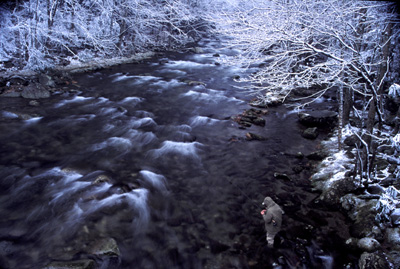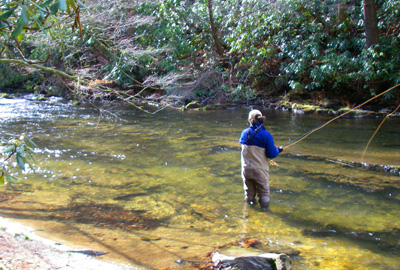Fly fishing in the winter can be a difficult proposition. The weather is cold, hatches can be sparse, and the fish are generally sluggish. However, there are plenty of reasons to go fishing. Crowds are at a minimum, the fish aren’t so jaded since few anglers are casting at them, and keeping in practice makes your spring and summer fly fishing more productive. Here are the top 10 things to keep in mind when you take to the water this winter.
1. Dress for the Occasion – There are few things in the world more miserable than being cold and wet and this is the number one reason why most people avoid fishing in the winter. Cold and wet are standard conditions on a river in the winter. As outdoor professionals we rely on the creed, “There is no such thing as bad weather, just bad equipment.”
Leave your cotton socks in the drawer. Wear wool socks which are warmer. Long underwear is essential. We like capilene tights with something heavier over them. Heavy fleece pants are excellent. Turtle neck or zip neck undershirts are a good base layer. Wear a warm shirt over that plus a good jacket. Windproof fleece jackets are among the best since they block any breeze from chilling you. However, a light windbreaker or rainjacket worn over a heavy fleece jacket or pullover will achieve the same thing.
A warm hat will do more to keep you warm than almost anything else. A simple stocking cap will work fine and is often the most effective piece of head gear. Be sure to wear something that keeps your ears covered and warm.
Fleece gloves are the last piece of essential gear. We prefer the fingerless variety that still allow us some dexterity for tying knots and stripping fly line. Try to find gloves that only expose your fingertips, not the whole finger.
2. Head to the Best Destination for the Conditions – Not all rivers fish the same in the winter. Tailwaters fish much differently than natural freestone trout streams. Extended cold snaps will keep the water temperatures extremely on mountain streams where you might even find a skim of ice on the bigger pools of water. Tailwater rivers will always have moderate water temperatures. Sometimes the water temperature is similar to what it is in the spring so tailwaters are always the best choice on the coldest days.
Many tailwaters like the South Holston in northeast Tennessee will have phenomenal Blue Wing Olive hatches during foul weather. However, some tailwaters will have massive midge emergences on sunny days. While fish will feed aggressively on these miniscule midges during these times, they can also be maddeningly selective. If the weather has been relatively mild for several days we often fare better fishing in freestone streams where the fish are rarely selective and feed more aggressively as the water warms.
3. Don’t be Afraid to Fish with Extra Weight – Trout in freestone streams aren’t likely to rise when the water is in the 40’s or colder. Tailwater trout are notorious for rising only during reliable insect emergences. Both of these facts make the point that you will have to fish a nymph to have a real opportunity at hooking fish in the winter months. Furthermore, extra weight that gets your fly close to the river bottom will improve your odds of drawing a strike.
Fish will not move about in the current when there is little or no food to be intercepted. For this reason fish will lie on bottom to conserve their energy and often won’t even be on the lookout for food drifting above them. A fly that is tumbling along the bottom is in the only place where a fish will likely eat it. A fly that drifts only a foot higher in the water may not even get a fish’s attention.
Use small split shot and crimp them on your leader 4″ – 10″ above your fly. This is an easy step that remarkably few fly fishers take. I can’t remember how many times one small split shot made the difference between a slow day of fishing and a day of reliable hook-ups.
4. Be Sure to Fish the Fly at the Proper Depth – This concept goes hand in hand with fishing extra weight. A heavy nymph fished too shallow is just as ineffective as an unweighted fly. The best policy is to fish your nymph rig about 30″ – 36″ under a strike indicator. This is a good average. If you’re not drawing strikes or hooking bottom, make the distance longer until one or the other starts to happen. Hooking bottom about one time in ten drifts is acceptable when the fish are moving slow. This shows you that your fly is consistently getting deep. Hooking bottom any more than that will only serve to cause aggravation as you repeatedly have to get flies off the bottom and perhaps retie your whole rig.
One rule we have is “If you’re not hooking fish, try to hook bottom.” Gradually fish the fly deeper until you either start getting strikes or snag bottom. Again, the occasional snag on the bottom is a positive, but repeated hang ups are reason to shorten it up.
5. Fish at the Appropriate Time – Much of the best activity will occur in the middle of the day so try to time your schedule to coincide with that. Show up too early and you might just get cold while fish aren’t feeding. Show up too late and you might miss the best part of the day.
Eat a big breakfast and hit the water around 10:00 – 11:00 AM when the day has started to warm up. If it’s a clear day the sun will begin to stir some activity. Some of the best fishing takes place from noon to mid-afternoon so taking a lunch break may cause you to miss the best part of the day. Keep some snacks your jacket or fishing vest along with a bottle of water. A small thermos of warm coffee or cocoa is even better. This allows you to grab a bite or have something warm to drink without taking a long break during the most productive time. Fishing will usually begin to trail off around 4:00, sometimes later on tailwaters, but it’s typically dark shortly after 5:00.
Another timing issue to consider when fishing tailwaters is hitting the rise and fall of the water right. This is a huge consideration on tailwaters in the Southeast where water levels change daily, but not so much a factor on Western tailwaters. Insects will often start to hatch very well as the water falls. Short pulses of water from generators will also stir up some activity. This is only occurs on a few rivers where a short pulse is done to keep a minimum flow without sending a big wave of water that requires anglers to get out of the river for their safety.
6. Read the Water Differently – Reading the water is an essential skill for success on the water. However, there are more factors to consider when fishing in the cold weather. Shallow, riffles that are productive in the spring may be completely devoid of fish in the winter. Look for slower currents downstream of the riffle. This type of water is more conducive to find fish feeding on the small midges and nymphs that trout seek in the winter. Also look for deep slot where you can’t see bottom. These are excellent spots for sluggish trout to lie when they aren’t feeding aggressively. Avoid shady stretches of water. This is more important in mountain streams than it is on tailwaters, but may still be a factor. Bugs and fish both seem more active while the sun is on the water. Midges and caddis are more active in the sunshine than shade. This important only on sunny days. Overcast days often find fish behaving the same in most sections of the river and Blue Wing Olive mayflies usually prefer such conditions.
Fish the sunny spots on mountain streams
7. Temper Your Expectations and Enjoy the Fishing – A day fishing in the cold weather is rarely as productive as the warm days of spring or the mild days of autumn. Learn to take pleasure in the extra solitude that the cold weather provides and find delight in the occasional rising trout you find. I’ve always thought that a fish caught in foul weather is worth three caught on a nice day and a rising trout caught in the winter is worth ten caught in the winter or spring.
One of my favorite fly fishing memories was catching a hatch on Abrams Creek in Great Smoky Mountains National Park as snow started to fall one February day about 10 years ago. I had caught several fish on beadhead nymphs before realizing some splashes on the water were rising trout, not something falling from the trees. I don’t remember how many fish I caught or how large they were, but I do remember the rises and the world slowly turning white. I was the only person on the Cades Cove loop road as I passed scattered groups of whitetail deer grazing in the meadows.



